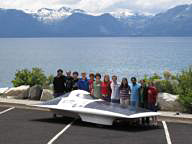Aug 2 2009
Panasonic Corporation (NYSE: PC) today announced its support of the Solar Electric Vehicle Team at the Massachusetts Institute of Technology (MIT SEVT), in their participation of the Global Green Challenge (GGC), to be held in October 2009 in Australia. Under the sponsorship agreement, Panasonic is providing the MIT SEVT team with its high-capacity (2.9 Ah), lithium-ion batteries to be used in the team's vehicle. Panasonic will have the right for its logo to appear on the body of the vehicle.

The Global Green Challenge evolved from the World Solar Challenge, a solar car race first held in 1987 in Australia. Today, the Global Green Challenge includes the World Solar Challenge for solar powered cars, and the Eco Challenge for other types of environmentally conscious production cars including fuel cell, electric and hybrid vehicles.
Teams from universities, corporations and other groups from around the world will compete, driving across the Australian continent from Darwin in the north, to Adelaide in the south, over a distance of 3,021 km.
The MIT SEVT student team will compete in the World Solar Challenge with a solar powered car using Panasonic lithium-ion batteries to store its solar generated power. Separately, Panasonic will provide the same high-capacity, lithium-ion batteries to a team from Japan's Tokai University which is also competing in the same category.
Solar cars use motors which run on electricity generated by solar panels. Excess electricity is stored in their batteries. The batteries supply electricity to the motor when the electricity from the solar panel is insufficient, due to overcast skies or at night. In other words, the performance of solar cars in races depends not only on the capability of their solar panels, but also the capacity of the batteries and the weight of the battery module.
Panasonic is providing both teams with its 18650-type cylindrical high-capacity, lithium-ion battery cells which are then mounted in arrays within a storage battery module. The same type of battery cells are widely used in laptop computers. Because this type of battery, which features the highest level of energy density, is light and high capacity, it lasts longer and enables making battery modules lighter. Both teams selected the Panasonic batteries to get an edge in the race that will be run under harsh weather conditions.
Panasonic, which is committed to environmental protection, believes the Global Green Challenge will present an opportunity for the company to explore new applications of its high-capacity, lithium-ion batteries.